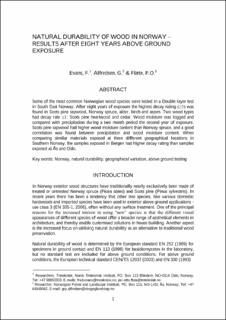Natural durability of wood in Norway - results after eight years above ground exposure
| dc.contributor.author | Evans, Fred G. | |
| dc.contributor.author | Alfredsen, Gry | |
| dc.contributor.author | Flæte, Per Otto | |
| dc.date.accessioned | 2020-08-20T07:59:18Z | |
| dc.date.available | 2020-08-20T07:59:18Z | |
| dc.date.created | 2017-10-17T15:29:02Z | |
| dc.date.issued | 2011 | |
| dc.identifier.isbn | 9788231101390 | |
| dc.identifier.uri | https://hdl.handle.net/11250/2673112 | |
| dc.description.abstract | Some of the most common Norwegian wood species were tested in a Double layer test in South East Norway. After eight years of exposure the highest decay rating (≥3) was found in Scots pine sapwood, Norway spruce, alder, birch and aspen. Two wood types had decay rate ≤1: Scots pine heartwood and cedar. Wood moisture was logged and compared with precipitation during a two month period the second year of exposure. Scots pine sapwood had higher wood moisture content than Norway spruce, and a good correlation was found between precipitation and wood moisture content. When comparing similar materials exposed at three different geographical locations in Southern Norway, the samples exposed in Bergen had higher decay rating than samples exposed at Ås and Oslo. | |
| dc.language.iso | eng | |
| dc.relation.ispartof | Proceedings of the 7th meeting of the NORDIC-BALTIC NETWORK IN WOOD MATERIAL SCIENCE & ENGINEERING (WSE) | |
| dc.title | Natural durability of wood in Norway - results after eight years above ground exposure | |
| dc.type | Chapter | |
| dc.description.version | publishedVersion | |
| dc.source.pagenumber | 1-6 | |
| dc.identifier.cristin | 1505291 | |
| cristin.ispublished | true | |
| cristin.fulltext | original |
